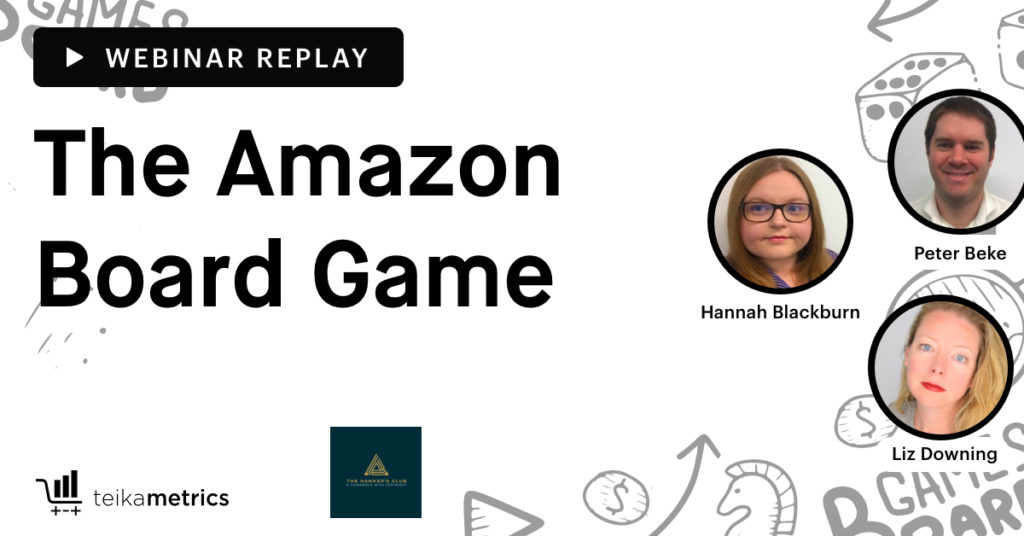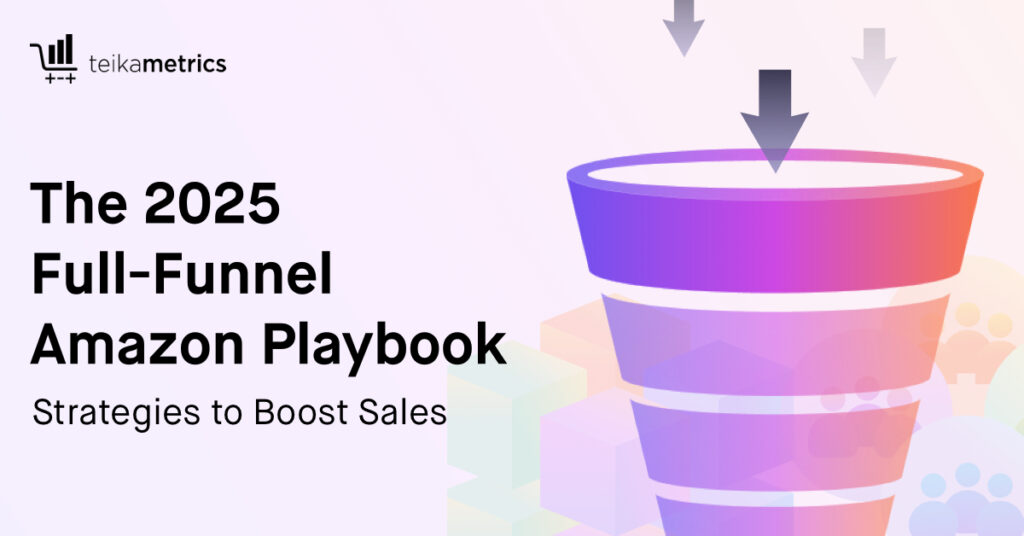Amazon’s rules for vendors are like a board game. They’re specific, can’t be changed, and you have to follow them if you want to win. You don’t need the best wholesales or the biggest marketing budget to succeed, you just need to stick to the rules. In this webinar, Hannah Blackburn and Peter Beke, co-founders of The Hawker’s Club, join us to discuss how vendors can make the right strategic decisions that both comply with the rules and put them ahead of the competition.
Webinar Teika-ways
- Play by Amazon’s rules
- Learn the players of the game
- Keep your brand, Amazon, and the customer in sync
- Take an infinite approach instead of finite
- Start making changes when it gets you a reward
- Understand one and two-way doors
- Consistency is equally important to balance
Show Links
- Check out The Hawker’s Club
- Connect with Hannah Blackburn on LinkedIn
- Connect with Peter Beke on LinkedIn
- Check out Teikametrics
- Connect with Teikametrics on Twitter or LinkedIn
- Read What Vendors Miss When Considering Switching To Seller Central
- Read On Seller Central, I Have More Control – Is It Really True?
Watch the Full Replay:
Key Teika-ways:
05:38 – Play by Amazon’s rules
Hannah said that within vendor central, Amazon’s rules are like a board game. The vendors that win are the ones who stick to the rules.
“Amazon rules are structured like a board game that’s specific. They might as well be written down and be in the box next to the dice and they’re set. They’re something that Amazon doesn’t let you change, even if you’ve got the best explanation in the world. Even if they are illogical, you just have to keep playing. We’ve done a study and we found that especially the brands that we work with, sometimes they might not be the best on wholesales. They might not be the best on pricing, they might not even have the best marketing budget, but they know the rules of the game and they’re playing it Amazon’s way. And they’re making sure that they always stick to those rules and they don’t think, oh, we can clean it up later because they know going in that it makes sense. And the most important part is, and I like to think of it as Amazon have a game of 21s, everybody’s looking at what their competitors are doing, and you can get very distracted that way, but you have to not forget that you’re actually all playing the house. You’re not playing each other.”
07:08 – Learn the players of the game
Peter said to ignore the competition. Instead focus on the three main players: the vendor or brand, the customer, and Amazon.
“When we look at and obsess about the competition, they operate with a different business model, different supply chain, different cost structure. And so whatever they may do, you may not be able to replicate. So trying to sort of copy them and reactively go after the competition has never led to great results, not even on Amazon either. And so when we look at who are the players of the game, this is very important, obviously. We’ve got up top the vendor community or the sellers or the brands and on the right-hand side, I’ve got a customer who ultimately purchases the product. And then of course Amazon. Now the important piece here is that all of these three players are connected. And if the connection remains intact, then ultimately we are good because what we want from a long-term perspective is that these players walk together in sync, in balance, and they progress forward together. If we eliminate one of the links in between any of the players, then we’ve got a problem.”
09:27 – Keep your brand, Amazon, and the customer in sync
Peter said keeping the three players in sync is difficult, but necessary to maintain your business over time. If one side is left behind, the whole game collapses.
“Let’s say a new product launched that a brand would like to bring to life, launch it on Amazon. And ultimately they want to go in very aggressive, submit a low wholesale price to Amazon, set the MSRP and the list price low as well to make sure the conversions happen and the work starts ramping up. Now, in that case, the customer obviously is going to be happy. So the sync between the brand and the customer is going to be there. Amazon is going to be happy because ultimately the wholesale’s low, that retail’s low, the customers are buying it. So that’s going to be also good. However, later down the line, let’s say the brand is not allowed to put in a wholesale increase, which obviously is a very timely conversation here. And so then this link between the brand and Amazon is going to be broken. The vendor’s out of sync because it’s no longer in the game. Amazon and the customer move forward together but the brand lags behind. And so it needs to be fixed. And if we spin the table around and just play a little with the variables. If we set the retail price too high so that the wholesale price can be high as well, then Amazon and the brand are automatically going to be okay with it, but the customers may not convert. And so again, we’ve got two players here that are in sync, the third one, not so much.”
16:22 – Take an infinite approach instead of finite
Peter said that there used to be vendor managers to keep the sides in sync, but now vendors need to be proactive instead of reactive to algorithm changes.
“If you take a finite approach and we focus on, are we good today? What we aren’t doing is thinking about our future because the new program, the governing algorithm change is going to come in and it is going to come in. And then all of a sudden our runway is extremely short to adapt to the new process to adapt to the new programs. If however, we take the rather infinite view to how do we make decisions systematically every day that helps ourselves, helps the customer, and helps Amazon’s contribution margins as well. In that case, all of a sudden we started first managing Amazon’s P&L on their behalf proactively. And number two, started making the first steps to build a runway for ourselves in case something goes wrong in case there’s a process change we need to go through that wasn’t there yesterday. And Amazon just brought in as a new rule that we all have to adopt. And so all our ASINs will receive that safety net or buffer that it used to have with the VM, just in a systematic way without the VM.”
21:11 – Start making changes when it gets you a reward
Hannah explained that shipping in your own container (SIOC) used to be rewarded, then it was required, then you were fined if you didn’t do it. Pay attention to suggested changes as they come and you’ll end up ahead.
“Our advice on this is to watch what Amazon is saying, hey, this is great, you’ll get a reward or, hey, this is great, it’s free. And try that, understand it, commit resources to it as soon as possible. And that means that any mistakes you make will be really cheap or they will be pretty much free. And you’ll get to learn how it works for your business. So one right now is Amazon Posts. Learn what works for your business before Amazon make it, where it’s you have to pay for every single click you get and then any bad posts you do is going to be pretty painful. Right now it’s okay. We can put that down to learning. It just cost us our time and move on. And that means that as Peter said, you have a longer runway to succeed. You have a lot more mistakes you can make. And ultimately the gap between Amazon asking nicely and forcing you is also the head start you’ll get between yourself and your competition.”
22:43 – Understand one and two-way doors
Hannah said that like in a chess game, most decisions that you make as an Amazon vendor are those that can change direction, but some are one-way decisions that can’t be reversed.
“Most of the decisions you make with Amazon, most of the pieces you move in a chess game, you can move them back again, maybe different directions. Maybe not exactly where they came, but there is movement. However, there’s certain decisions which are the pawn of the chess game. You move it forward and that is where it is. You can only keep going forward. You can’t move back and you can’t move sideways. And that’s something that you have to remember when you’re making an Amazon decision. If you can move it, move fast. Like Amazon posts, like SIOC, try it out, roll it back. If you can’t move it, as an example, increasingly certain content changes on Amazon where they say the first content we ever get is the one that we’re going to stick with. Or certain programs that you go into such as it’s very hard to get back, you’ll collect freight if you decide to move away from the prepaid freight. That’s the kind of thing where you need to study it. You need to be ready and you need to very, very much understand that we have to live with this decision, but also have the confidence that most pieces, again, like on the chessboard, like a two-way door, can be changed or reversed.”
27:14 – Balance the triangle
Peter said that you always have to check that the triangle is balanced when making decisions, like with ad spending.
“So we make a decision, which is put some more ad dollars towards the product. We can say that’s an immediate win and ultimately we’ve made ourselves happy. That’s good. We can say that the customer, the second player also wins because now we are enabling them again to see our products and, and be able to enjoy our product again. So we can count it as a win for the customer. But if there is an underlying Amazon profitability problem, we forgot to fix that. And this is why ultimately one of the three players get out of sync. They don’t move hand in hand in balance together. And so ultimately the triangle will start breaking down and we’ll start seeing lower sales numbers and ultimately more and more problems with the account. So, this is an example when we played for the immediate win with a finite approach.”
29:22 – Consistency is equally important
Peter said that staying consistent in product, packaging, and delivery will build Amazon’s trust in you and the customer’s trust in you.
“Consistency is equally important concept when it comes to Amazon as having all three players in sync, because algorithms look for consistency and reliability. What they’ll be looking for when deciding should I show your ASIN to the customer or should I show to someone else’s is, are you going to be able to deliver on all the promises that you just make on the detail page and not the next time or the next a hundred out of a hundred times, a thousand out of a thousand times. And are you going to be able to make your ship window or are you going to start racking up late shipment notices? Are you going to be able to deliver a product intact or is the product going to have damaged packaging? Is the product going to be cracked at some places so that ultimately it creates a customer return. Which again, then breaks the sync between Amazon and the customer on the bottom end of the triangle. And so ultimately ASINs and vendors and brands that adopt the consistent approach on Amazon tend to get not only higher share of organic revenue, but ultimately an increase conversion rate as well because the algorithm trusts them more.”
40:45 – Make changes with an infinite view
Peter said a VM used to help a vendor figure out the length of runway they had with Amazon when changing prices or making those types of decisions. Now they have to maintain an infinite view on their own.
“Now it’s down to us to try to get a good estimate, how long of a runway the product has. Tying back to the previous concepts that we introduced. Ultimately, I don’t know, none of us does, what the contribution margin expectation is within the category. Adopting the finite view, focusing on the next quarter or next year, we are not going to create that runway. But the way we can maximize that runway is adopting the infinite view and starting to make decisions ticking all the boxes here, not only for short-term, but long-term that ultimately is going to keep increasing the runway we have in case a change comes in and in case we need to adopt our own internal processes to again fit the new governing regulations and rules of the game. And so ultimately, there is a financial figure attached to all of these three pieces in addition to the length of an estimated runway, which ultimately is going to tell everyone how long they have until they need to change the way they are doing things.”
42:25 – Stay consistent with decisions
Hannah said that you need to evaluate all of your decisions based on what type of game piece it is and what the price for it is, and then stay consistent.
“Ultimately whenever you’re making a decision, decide is this just a normal chess piece? Is it a pawn? Can I come back from this? Think about the three most important people in this: you, the customer, the house or Amazon. Or to be honest, whichever marketplace you’re on at that moment and you’re deciding for at that moment. And then the ‘when’ you do needs to be as consistent as possible. It can’t be we’ll do it now and then we’ll be able to cycle back. It’s gotta be, how do we do it today, tomorrow, in five years’ time? Remember that if you’re not consistent, Amazon will not let you get away with it for free. Although I’m sure I’m not surprising anyone on this call to tell them that. Everyone’s probably nodding behind their screens. And then ultimately the last part is every decision has a price. And you need to be comfortable that you’re paying it, but most importantly, aware what that price is so that you can make those decisions that you need to make so that you can go forward as confidently as possible.”





